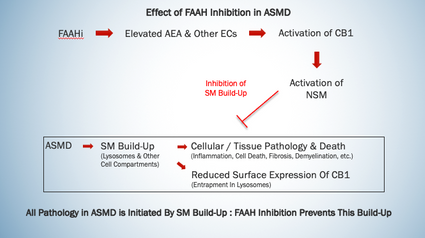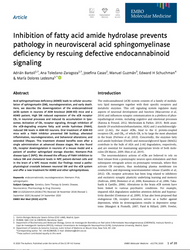Inhibition of Fatty Acid Amide Hydrolase (FAAH) for ASMD

Our recent research revealed a down regulation of the endocannabinoid (eCB) system in neurons of ASM knockout mice (ASM-KO), a well established and validated animal model for Infantile Neurovisceral ASMD (NPA), and a ASMD-A patient. Additionally, we demonstrated high sphingomyelin (SM) levels reduced expression of the eCB receptor CB1 in neuronal processes and induced its accumulation in lysosomes.
Armed with this new understanding and prior knowledge that activation of CB1 receptors can degrade SM by activating neutral sphingomyelinase (NSM) which is distinct from acid sphingomyelinase (ASM) and not defective in ASMD patients, we are exploring the therapeutic benefit of CB1 activation in the presence of ASMD.
Anandamide (AEA) is a primary eCB that binds to the CB1 receptor which is largely abundant in the brain, and the enzyme fatty acid amide hydrolase (FAAH) contributes to the bulk of AEA degradation. Wylder Nation's FAAHi program is exploring the use of a class of molecules called FAAH inhibitors to a) recover defective CB1 signaling, and b) correct the underlying SM accumulation that occurs in ASMD.
We strongly believe this unique approach could have profound effects in treating the neurological manifestations of ASMD and other Lysosomal Storage Disorders, and is the subject of a two patents filed by Wylder Nation Foundation.
The promising results of some of this work was recently published in EMBO Molecular Medicine which you can read in full by clicking the article in the sidebar



